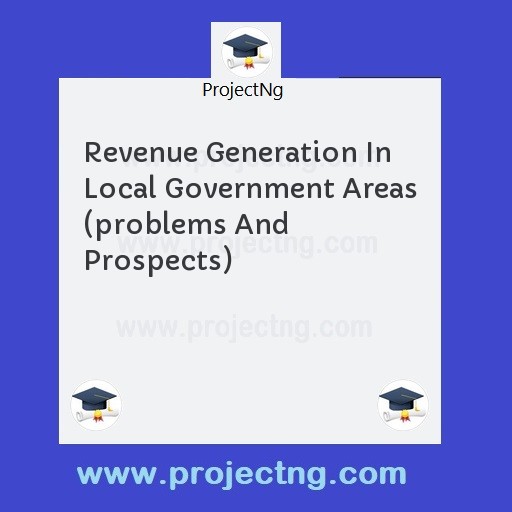Revenue Generation In Local Government Areas (problems And Prospects)
Accounting Project Topics
Get the Complete Project Materials Now! »
REVENUE GENERATION IN LOCAL GOVERNMENT AREAS (PROBLEMS AND PROSPECTS)
ABSTRACT
The adverse situation in the various local government areas of Nigeria has led the researcher to go into this very topic. Hence, the purpose of this work is to enlighten people, mostly students in the school of financial studies on how revenue is generated in local governments, problems confronting them as regards revenue generation as well as prospects to the problems.
However, local governments are expected to use the fund generated in embarking on income earning projects, projects, that come under fee or bill charging utilities like portable water, electricity, construction of market squares etc.
However, before fund can be generated, one must make ways of getting the funds like grants given to local governments for some purposes by the federal government. The central government also determines the sources, extent, purpose and maximum duration for which borrowing is to embark upon by the local government and not just going ahead to borrow.
Local government raise loans to purchase plants and equipment, as well as other projects whose costs are too great for them to embark on at a time.
Furthermore, local authorities in Nigeria are responsible for the establishment and maintenance of public motor parts, bad roads, market squares etc.
It is therefore recommended for students in the school of financial studies at all level (who will be opportune to lay hands on this write up) as a ground for the much needed funds internally generated revenue to facilitate projects execution by local governments.
TABLE OF CONTENTS
TITLE PAGE i
APPROVAL PAGE ii
DEDICATION iii
ACKNOWLEDGEMENT iv ABSTRACT v
TABLE OF CONTENTS
CHAPTER ONE:
1.0 INTROUCTION 1
1.1 STATEMENT OF PROBLMS 3
1.2 OBJECTIVE OF THE STUDY 5
1.3 SIGNIFICANCE OF THE STUDY 6
1.4 SCOPE, LIMITATION AND DELIMITATION 7
1.5 DEFINITION OF TERMS 8
CHAPTER TWO:
REVIEW OF RELATEDLITERATURE
2.0 EXTERNAL SOURCES OF FUNDS 10
2.1 FINANCIAL TRANSFER 11
2.2 GRANTS 14
2.3 LOANS 17
2.4 INTERNAL SOURCES OF FUNDS 19
2.5 PERSONAL INCOME TAX 19
2.6 COMMUNITY TAX 20
2.7 LOCAL RATES 21
2.8 FEES AND CHARGES 22
2.9 COMMERCIAL UNDERTAKINGS 24
2.10 COURT FINES AND FEES 26
CHAPTER THREE:
RESEARCH METHODOLOGY
3.0 SOURCES OF DATA 29
3.1 LOCATION OF DATA 30
3.2 ANALYSIS OF DATA 30
3.3 RESEARCH POPULATION 31
CHAPTER FOUR:
SUMMARY OF FINDINGS
4.0 SUMMARY 32
CHAPTER FIVE:
RECOMMENTION AND CONCLUSION
5.0 RECOMMENDATION 35
5.1 CONCLUSION 35
BIBLOIGRAPHY 37
CHAPTER ONE
1.0 INTRODUCTION:
BACKGROUND OF THE STUDY:
Nigeria has three- tiers of government systems,
These are; (i) The federal government
(ii) The state government and
(iii) The local government.
The essence of this division of government into federal, state and local levels is to enable the government exercise her administration easily and effectively. However the 1979 constitution spells out the functions of each level of government. Generally it can be said that the governments are responsible for the provision of the collective (social) goods and services on a non- commercial basis as well as the provision of other social and economic services. In order to meet up with the foretasted goals and services, the government needs to collect revenues.
Local government, which this work emphasizes on, can be described as the government at the local level, exercised through representative council, established by law to exercise specific power within definite areas. The government of such body is selected or otherwise locally selected.
The administering of government at local level in Nigeria traced as far back as colonial period, when native authorities were established in their rudimentary forms, that is in their own ideas. They represented a system of indirect rule, which sought to establish a form administration through traditional authorities
Between 1950 and 1955, the first elected local government council based on the model was shadbushes in logos and in the former Eastern and western Region. Though, the traditional members constituted a maximum of 25 percent in most of the councils, the emergence of members elected on a political basis instigated the traditional rulers to gradually withdrawn from active participation in local administration in Nigeria.
Presently, local government administration is still in existence assigned with numerous. Responsibilities like, bawling of market square, provision of pipe-born water, motor parks, rehabilitation of local and rural roads, sanitary and health inspection, maternity home and dispensaries e t c.
Finally, local governments have two (2) main sources of revenue or fund. They are
(i) External sources of fund.
(ii) Internal sources of fund.
The External sources of fund include;
(a) Statutory allocations from the federal and state government (i.e., 20% considered federal revenue and 10% of internally generated state revenue).
Special grants which aim at assisting local government finance their aforementioned projects. In addition, local government source fund internally through receipts on rent and rates on their
Be the First to Share On Social

Enjoying our content?
Don't miss out on new videos! Subscribe to our YouTube channel for more awesome content.
Subscribe Now!













